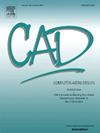TiPGAN: High-quality tileable textures synthesis with intrinsic priors for cloth digitization applications
IF 3.1
3区 计算机科学
Q2 COMPUTER SCIENCE, SOFTWARE ENGINEERING
引用次数: 0
Abstract
Seamless textures play an important role in 3D modeling, animation, video games, and Augmented Reality/Virtual Reality, enhancing the realism and aesthetics of the digital environments. Despite its significance, generating seamless textures is not trivial, requiring the edges of the synthesized texture image to represent a continuous pattern when tiled. Although traditional methods and deep learning models have made good progress in texture synthesis, they often fail in ensuring the seamless property of the synthesized textures. In this paper, we report on TiPGAN, a Generative Adversarial Network (GAN) model, which we developed to generate seamless textures. Leveraging the inherent intrinsics of seamless textures as priors, our model introduces two novel modules: a Patch Swapping Module, for maintaining texture continuity through diagonal patch swapping, and a Patch Tiling Module, for ensuring seamless repetition across tiles. To overcome the limitations of existing image quality metrics in evaluating tileability, we introduce a new metric, termed Relative Total Variation (RTV), for assessing the smoothness and continuity of the synthesized textures. Our experimental results demonstrate that TiPGAN outperforms existing methods in generating high-quality, seamless textures, as validated by both conventional image quality metrics and our newly proposed RTV metric. This research represents a significant advancement in texture generation, offering valuable applications in graphic design, virtual reality, and digital art. Our code and dataset are available at https://github.com/VickyHEHonghong/TiPGAN.
高品质的瓷砖纹理合成与固有的先验布料数字化应用
无缝纹理在3D建模、动画、视频游戏和增强现实/虚拟现实中发挥着重要作用,增强了数字环境的真实感和美感。尽管具有重要意义,但生成无缝纹理并非易事,它要求合成纹理图像的边缘在平铺时代表连续的图案。传统的纹理合成方法和深度学习模型虽然在纹理合成方面取得了很好的进展,但往往不能保证合成纹理的无缝性。在本文中,我们报告了TiPGAN,一个生成对抗网络(GAN)模型,我们开发的无缝纹理生成。利用无缝纹理的固有特性作为先验,我们的模型引入了两个新颖的模块:一个补丁交换模块,用于通过对角线补丁交换保持纹理连续性,以及一个补丁平铺模块,用于确保瓷砖之间的无缝重复。为了克服现有图像质量指标在评估纹理平滑性方面的局限性,我们引入了一种新的度量,称为相对总变化(RTV),用于评估合成纹理的平滑性和连续性。我们的实验结果表明,TiPGAN在生成高质量、无缝纹理方面优于现有方法,并得到了传统图像质量指标和我们新提出的RTV指标的验证。这项研究代表了纹理生成的重大进步,在平面设计、虚拟现实和数字艺术中提供了有价值的应用。我们的代码和数据集可在https://github.com/VickyHEHonghong/TiPGAN上获得。
本文章由计算机程序翻译,如有差异,请以英文原文为准。
求助全文
约1分钟内获得全文
求助全文
来源期刊

Computer-Aided Design
工程技术-计算机:软件工程
CiteScore
5.50
自引率
4.70%
发文量
117
审稿时长
4.2 months
期刊介绍:
Computer-Aided Design is a leading international journal that provides academia and industry with key papers on research and developments in the application of computers to design.
Computer-Aided Design invites papers reporting new research, as well as novel or particularly significant applications, within a wide range of topics, spanning all stages of design process from concept creation to manufacture and beyond.
 求助内容:
求助内容: 应助结果提醒方式:
应助结果提醒方式:


